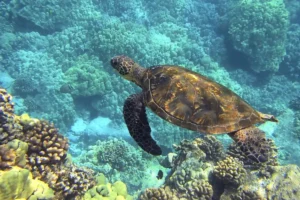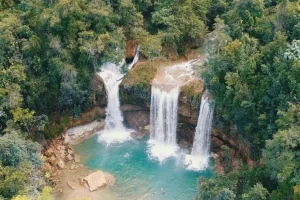The climate in the Dominican Republic generally offers images of endless sunshine, pristine beaches, and swaying palm trees. In fact, this is for a good reason: a year-round sunshine. However, to truly unlock the best time to visit and avoid any unexpected surprises, understanding the details of its tropical climate is crucial.
This guide will delve into the distinct seasons. Therefore, you can tailor your luxury escape to perfectly match your desires, whether you seek tranquil relaxation, thrilling adventures, or cultural immersion.
Climate in the Dominican Republic and its diverse seasons
First of all, the climate in the Dominican Republic is primarily tropical. This means it is characterized by consistently warm temperatures and distinct wet and dry periods. While the overall warmth remains constant, understanding these seasonal variations is crucial for planning your ideal trip.
Also, this ensures your experience aligns with your expectations, from sun-drenched days to lush, vibrant landscapes.
The dry season: sunshine and serenity
For many, the dry season represents the classic Dominican Republic experience. Typically lasting from December to May, these months are characterized by minimal rainfall and abundant sunshine. As a result, they are highly popular among visitors seeking uninterrupted outdoor activities.
Average temperatures during this period hover comfortably between 25∘C (77∘F) and 30∘C (86∘F), with cooler evenings, particularly in mountainous regions. Also, humidity is generally lower, contributing to a more comfortable climate.
This season is ideal for those who prioritize long days on the beach, watersports, or exploring historical sites without the concern of rain. The clear skies and gentle breezes create perfect conditions for sailing, snorkeling, and simply basking in the tropical warmth.
Navigating the rainy season: lush landscapes and fewer crowds
The rainy climate in the Dominican Republic generally runs from June to November. However, it’s essential to correct the misconception of continuous downpours. Rainfall often occurs in short, intense bursts, typically in the late afternoon or early evening. This leaves plenty of sunshine for morning and early afternoon activities.
In contrast, temperatures remain warm and are often slightly higher than in the dry season. They can range from 28°C (82°F) to 32°C (90°F) and are accompanied by increased humidity. This period transforms the island into a vibrant, lush paradise. Consequently, waterfalls flow powerfully and vegetation is at its most verdant.
For eco-tourists or those seeking a more authentic experience with fewer crowds and potentially lower prices, the rainy season can be an excellent choice. It’s also a fantastic time for river adventures and exploring the island’s interior, where the refreshed landscape truly shines. Understanding the climate patterns during these months can lead to a truly unique and rewarding visit.
Hurricane season preparation: planning for peace of mind [1]
The official hurricane season runs from June 1st to November 30th. The peak months are typically August and September (U.S. Embassy, 2025). Even though the chance of a direct hit is low, it’s a time for awareness and planning. Modern forecasting enables ample warning, allowing travelers and local authorities sufficient time to take necessary precautions. For those considering travel during this period, comprehensive travel insurance is highly recommended.
During hurricane season, you should also take into account the Saharian Dust storms on Atlantic Oceanic. First, let’s see what it is. NOOA (The National Oceanic and Atmospheric Administration) in the U.S, defines it as a mass of very dry, dusty air that forms over the Sahara Desert during the late spring, summer and early fall. This layer can travel and impact locations thousands of miles away from its African origins (NOAA, 2020).
To take care of yourself and loved ones when this phenomenon occurs, consider these tips to prevent allergies:
- Stay indoors.
- Use air purifiers.
- Wear masks.
- Stay hydrated.
- Manage symptoms with medication or seek medical advice if they are too strong.
Despite the potential for storms, many days during hurricane season are perfectly sunny and beautiful. It’s often when you’ll find the best deals on flights and accommodations, appealing to budget-conscious luxury travelers willing to monitor weather forecasts.
The key is to stay informed and flexible with your plans, allowing the climate in the Dominican Republic to guide your preparation.
Beyond the calendar: tailoring your Dominican adventure
This section will help you find the perfect window for your specific interests, ensuring the climate in the Dominican Republic enhances every moment of your journey. In fact, the island’s diverse offerings mean that there’s an ideal time for every type of traveler.
This section will help you find the perfect window for your specific interests. Ultimately, this ensures the climate in the Dominican Republic enhances every moment of your journey.
Best climate in the Dominican Republic for beach lovers
For those whose ideal vacation involves endless hours soaking up the sun on pristine beaches, the dry season is perfect. Indeed, this period from December to May is unequivocally the best time to visit the Dominican Republic. During these months, you can expect consistently clear skies, low humidity, and gentle ocean breezes. Furthermore, you can enjoy the perfect conditions for lounging, swimming, and watersports.
Punta Cana, La Romana, and Samaná are especially popular during these ideal conditions. The calm turquoise waters of places like Bávaro Beach or the secluded coves of Las Terrenas are at their most inviting.
While you can enjoy the beaches year-round, the dry season offers the highest probability of uninterrupted sunshine for your seaside relaxation.
Optimal seasons for adventure seekers
The climate in the Dominican Republic offers distinct advantages for adventure enthusiasts, depending on their chosen activity. For example, for hiking and exploring the mountainous interior, like Jarabacoa or Constanza, the dry season is preferable due to lower rainfall and more accessible trails. However, for white-water rafting on the Yaque del Norte River, the rainy season (June to November) actually offers higher water levels and a more exhilarating experience.
Surfing conditions can be excellent year-round, but the northern coast (Cabarete, Sosúa) sees more consistent swells during the winter months (November to April). Besides exploring caves or zip-lining through the canopy, these activities are generally enjoyable regardless of the season, though the dry season offers more comfortable temperatures for strenuous activity. Irrespective of when you choose to go, the island’s diverse topography ensures an adventure is always within reach.
Cultural immersion and gastronomy: when to enjoy
In particular, experiencing the vibrant culture and rich gastronomy of the Dominican Republic is a delight, regardless of the season. However, certain times offer unique advantages. Suppose you wish to participate in major festivals, such as Carnival (February to March) or the Merengue Festival (held in July in Santo Domingo). In that case, planning your visit around these events is key, regardless of the general weather patterns.
In fact, the relatively cooler temperatures of the dry season can make exploring historic colonial zones, like Santo Domingo’s Zona Colonial, more comfortable for walking and sightseeing. However, the slightly warmer, more humid months of the rainy season often coincide with the peak ripeness of many tropical fruits, leading to an abundance of fresh, flavorful produce in local markets and restaurants. This period can offer a deeper dive into the island’s culinary heart.
The climate in the Dominican Republic truly influences the availability of fresh, local ingredients, enriching your gastronomic journey.
Navigating the season with the climate in the Dominican Republic
Beyond general seasonal patterns, the climate in the Dominican Republic also influences a variety of specific events and activities throughout the year. Understanding these seasonal patterns helps refine your travel plans and improve your experience.
Seasonal events and natural highlights
For instance, whale watching in Samaná Bay is a prime example of a seasonal activity. From mid-January to late March, thousands of humpback whales migrate to the warm waters of the bay to mate and calve, creating an unforgettable spectacle. This period coincides conveniently with the dry season, providing excellent viewing conditions and calm seas.
Conversely, for those interested in exploring the island’s lush botanical gardens or enjoying the vibrant green landscapes, the rainy season brings the flora to life. Waterfalls like El Limón are at their most majestic after rainfall, making them perfect for photography and adventure. The increased rainfall also replenishes rivers, which is fantastic for activities like tubing or canyoning.
Consider also the impact on popular tourist spots. During the peak dry season, major attractions and resort areas can be pretty crowded. If you prefer a more serene and private experience, consider visiting during the shoulder months (late May to early June or late November to early December), which offer a good balance of pleasant weather and fewer tourists. The climate in the Dominican Republic during these transition periods often provides favorable conditions without the peak-season rush.
Wellness, golf, and quieter alternatives
Alternatively, for avid golfers, the dry season is ideal, providing consistent sunny days and perfectly maintained courses. The famous Teeth of the Dog course in Casa de Campo, for example, is delightful when conditions are dry and sunny, allowing for optimal play. The reduced humidity also contributes to a more comfortable round.
Wellness and relaxation
Finally, for those seeking wellness and relaxation, the climate in the Dominican Republic can significantly enhance your experience. The consistent warmth encourages outdoor yoga sessions, beachfront meditations, and invigorating swims. During the cooler, drier months, outdoor spa treatments feel especially refreshing.
In contrast, the increased humidity of the rainy season can be beneficial for skin hydration and a more profound sense of tropical immersion (Stadler Form, 2024).
Climate in the Dominican Republic: a gateway to unique experiences
The climate in the Dominican Republic offers a fascinating array of experiences throughout the year, each season presenting its unique charm and opportunities. The island caters to every desire, each season presenting unique opportunities. For example, the dry season offers sun-drenched days perfect for relaxing on pristine beaches. In contrast, the rainy season provides lush landscapes that are ideal for eco-adventures with fewer crowds.
Even during the hurricane season, with proper planning and awareness, you can discover hidden gems and enjoy significant value, all while experiencing the inherent beauty of this Caribbean paradise.
Curated experiences by Homebelike: your stay, your season
At Homebelike, we believe that your travel experience should be as seamless and personalized as possible, starting with the weather. Based on the climate in the Dominican Republic, we curate seasonal experiences tailored to your ideal getaway.
During the dry season, enjoy exclusive beachfront villas with private pools, sunrise yoga sessions, and personalized island-hopping itineraries. During the rainy season, our specialists recommend immersive jungle adventures, luxurious wellness retreats, and cozy hideaways ideal for tropical introspection.
Finally, during shoulder months, you’ll benefit from a perfect balance of good weather, privacy, and exclusive rates.
Choosing the best time to visit the Dominican Republic depends entirely on your travel style, but rest assured, every season has something special to offer. Our experienced specialists are with you from the moment you book, ensuring every detail is taken care of before, during, and after your stay.
Explore our handpicked destinations, browse our reserve collection, or discover the full range of listings. Let us help you experience the climate in the Dominican Republic the way it was meant to be, effortlessly and in style.
Discover our exquisite experiences and let Homebelike plan your Dominican Republic getaway. We will find you perfect weather at our luxury villas and exclusive properties. We create immersive experiences that reflect the country’s essence, focused on comfort and detail. Because your next adventure deserves more than just a place to stay, it deserves to be unforgettable.



